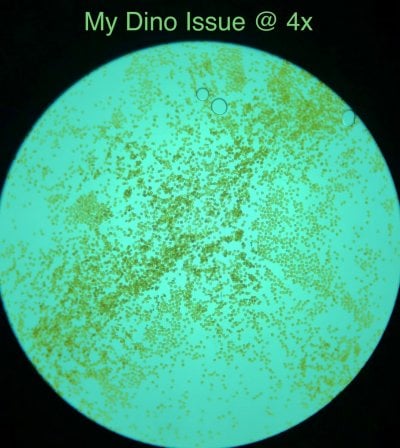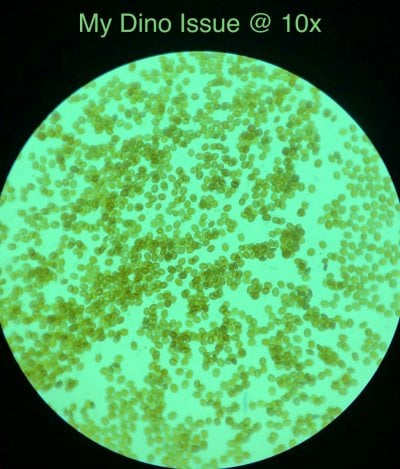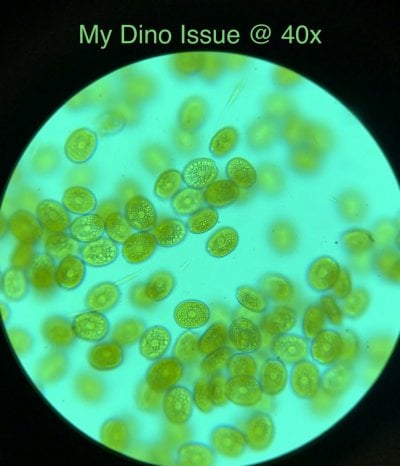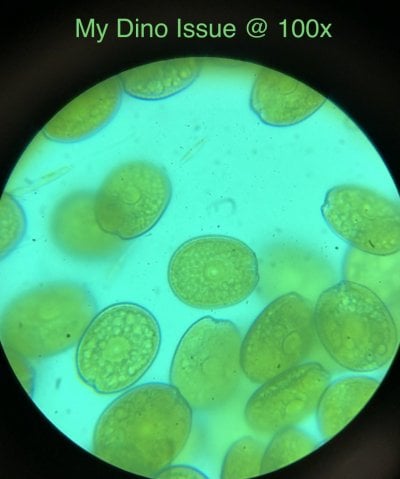Just post it?Alright, I might be speaking too early, but I believe I have triumphed over my ost dinos if anyone has any questions I will try my best to go over what I did they were gone OVERNIGHT.
Navigation
Install the app
How to install the app on iOS
Follow along with the video below to see how to install our site as a web app on your home screen.
Note: This feature may not be available in some browsers.
More options
You are using an out of date browser. It may not display this or other websites correctly.
You should upgrade or use an alternative browser.
You should upgrade or use an alternative browser.
Dinoflagellates – Are You Tired Of Battling Altogether?
- Thread starter mcarroll
- Start date
- Tagged users None
- Joined
- Mar 20, 2018
- Messages
- 88
- Reaction score
- 42
Lol, I know.. odd post.. 502 pages of people having this horrible problem but I solved it overnight. Think anyone might be interested?Just post it?
Yes, I do have one simple question for you if you please.... How?
Lol, I know.. odd post.. 502 pages of people having this horrible problem but I solved it overnight. Think anyone might be interested?
Yes, I do have one simple question for you if you please.... How?
Drain the tank. Sell everything. Done.
Man, no kidding....doing that crossed my mind a dozen times a day going through a dino war.
So I have been battling dinos for a while now. Please advise me on what to do. I already replaced my sand with new live sand but they came back
My NO3 is 5
PO4 is 0.076
Silica is .04 (using Hanna Silica LR tester)
What should my numbers be in order to beat these?
Looked under microscope again today. Lots of diatom on the glass and mag float but sand if full of Dino’s.
Yes his picture is from my mag float and hlasd

This picture is from my sand.

My NO3 is 5
PO4 is 0.076
Silica is .04 (using Hanna Silica LR tester)
What should my numbers be in order to beat these?
Looked under microscope again today. Lots of diatom on the glass and mag float but sand if full of Dino’s.
Yes his picture is from my mag float and hlasd
This picture is from my sand.
Only advice I would have is what solved my problem in the end (well, what managed my problem - I still have 'em they're just not visible). UV filter! Proper size and at least 8x turnover on flow (those dinos can reproduce like mad - something like 2x every 20 min). If my flow drops - I have do go dark for a day and crank it back up to get them invisible again.
I'm sure others might have better or better for you. Just my experience. Been ok with them now for 3 months.
I'm sure others might have better or better for you. Just my experience. Been ok with them now for 3 months.
I think they are the amphidinum which I don't think ae affected by uv.Only advice I would have is what solved my problem in the end (well, what managed my problem - I still have 'em they're just not visible). UV filter! Proper size and at least 8x turnover on flow (those dinos can reproduce like mad - something like 2x every 20 min). If my flow drops - I have do go dark for a day and crank it back up to get them invisible again.
I'm sure others might have better or better for you. Just my experience. Been ok with them now for 3 months.
I think they are the amphidinum which I don't think ae affected by uv.
So your first Pic looks like diatoms. Your second Pic kinda looks like Large Cell amphidinium.
Like you said, UV won't do much as they don't go into the water column. It's what I've been dealing with for over a month. Raise nutrients (N 10, P 0.1) and look at dosing Si (1-2ppm) That's what I've been doing.
I also stopped waterchanges.
It's not getting better, but it's definitely not getting worse. Just letting it play out while keeping everything as stable as possible. Doesn't seem to be effecting anything other than making CUC somewhat lethargic.
Has to be a dino that has part of lifecycle in water column. Mine are/were ostreopsis.I think they are the amphidinum which I don't think ae affected by uv.
- Joined
- Mar 20, 2018
- Messages
- 88
- Reaction score
- 42
Which species you think?
Today I had a major set back. ALL corals in the tank had a bad reaction to what I did last night. Either the 10ml of neonitro (90gal tank 30 gal Sump) or the uv sterilizer I added (blew a ton off the rocks to see if it would be killed off by uv better).. I thought maybe my nitrate test was bad so I bought one on the way home but still reads 0.. so I don’t think neonitro is to blame. I then wondered if the uv sterilizer killed so many at once causing the toxins to be released? I’m running carbon and contemplating doing a water change...
Today I had a major set back. ALL corals in the tank had a bad reaction to what I did last night. Either the 10ml of neonitro (90gal tank 30 gal Sump) or the uv sterilizer I added (blew a ton off the rocks to see if it would be killed off by uv better).. I thought maybe my nitrate test was bad so I bought one on the way home but still reads 0.. so I don’t think neonitro is to blame. I then wondered if the uv sterilizer killed so many at once causing the toxins to be released? I’m running carbon and contemplating doing a water change...
Attachments
- Joined
- Mar 20, 2018
- Messages
- 88
- Reaction score
- 42
My Phosphates are at 0.25 ppmWhich species you think?
Today I had a major set back. ALL corals in the tank had a bad reaction to what I did last night. Either the 10ml of neonitro (90gal tank 30 gal Sump) or the uv sterilizer I added (blew a ton off the rocks to see if it would be killed off by uv better).. I thought maybe my nitrate test was bad so I bought one on the way home but still reads 0.. so I don’t think neonitro is to blame. I then wondered if the uv sterilizer killed so many at once causing the toxins to be released? I’m running carbon and contemplating doing a water change...
Only advice I would have is what solved my problem in the end (well, what managed my problem - I still have 'em they're just not visible). UV filter! Proper size and at least 8x turnover on flow (those dinos can reproduce like mad - something like 2x every 20 min). If my flow drops - I have do go dark for a day and crank it back up to get them invisible again.
I'm sure others might have better or better for you. Just my experience. Been ok with them now for 3 months.
They can multiply quickly asexually. Ostreopsis can really get going quick as they are the most poisonous easily creating enough food to support rapid cell division.
Folks often say "I already have a UV running in-line and it is not working!" That is because the return pump runs them through so fast they are unaffected by it. Algae and bacteria have no armor (theca). Dinos do.
Unless you have a ridiculously oversized UV, you have to run slow.
I'm very confused now. I thought you're supposed to run your UV slow, not fast. So which is it?
For everything you want a high enough exposure to damage/kill the organism so it dies or cannot reproduce. That exposure is lower for algae (dino) than for protozoa (ich). However, algae can reproduce quickly so the flow needs to be higher to overcome the reproduction rate. For protozoa, relatively slow flow as possible to maximize exposure as the reproduction rate is less a factor than tolerance of uv exposure.I'm very confused now. I thought you're supposed to run your UV slow, not fast. So which is it?
I had undetectable nitrates and phosphates terrible Dino outbreak. Identified as ostreopsis. I got a huge bottole of copepods and phyto from an LFS in Ohio when I was visiting the state to go to IKEA of all places. I got fresh copepods and phyto that had been harvested THAT day. They sat in the car on the way home for about 3 hours no refrigeration. and I dumped the ENTIRE bottle of copepods in the tank and about half the bottle of phyto. I also added microbactr7 that I got from the same shop. next morning the tank looked insane almost zero sign of dinos. I also added 3 fish to the tank the next day. I was going to quarantine, but I was very impatiant. nitrates 20 phos 15ish overnight.Lol, I know.. odd post.. 502 pages of people having this horrible problem but I solved it overnight. Think anyone might be interested?
Yes, I do have one simple question for you if you please.... How?
I'm not going to lie It's very possible that those pods were dead from the drive. I have now put a 25w UV on the tank and haven't seen a trace of Dinos.
But @ScottB states the opposite for dinos. Lower exposure implies higher flow/turnover but on page 500 he states many times you want slow turnover for dinos..... Hence my confusion.For everything you want a high enough exposure to damage/kill the organism so it dies or cannot reproduce. That exposure is lower for algae (dino) than for protozoa (ich). However, algae can reproduce quickly so the flow needs to be higher to overcome the reproduction rate. For protozoa, relatively slow flow as possible to maximize exposure as the reproduction rate is less a factor than tolerance of uv exposure.
So which is it?
- Joined
- Mar 20, 2018
- Messages
- 88
- Reaction score
- 42
Thanks for sharing bud. I am glad to hear because I decided to dose algaebarn phyto and microbactr last night. Fingers crossed.I had undetectable nitrates and phosphates terrible Dino outbreak. Identified as ostreopsis. I got a huge bottole of copepods and phyto from an LFS in Ohio when I was visiting the state to go to IKEA of all places. I got fresh copepods and phyto that had been harvested THAT day. They sat in the car on the way home for about 3 hours no refrigeration. and I dumped the ENTIRE bottle of copepods in the tank and about half the bottle of phyto. I also added microbactr7 that I got from the same shop. next morning the tank looked insane almost zero sign of dinos. I also added 3 fish to the tank the next day. I was going to quarantine, but I was very impatiant. nitrates 20 phos 15ish overnight.
I'm not going to lie It's very possible that those pods were dead from the drive. I have now put a 25w UV on the tank and haven't seen a trace of Dinos.
best of luck, I honestly believe that it was mainly raising nutrients. I did a few things at once though so there is no telling really. I'm just happy to be past it... for nowThanks for sharing bud. I am glad to hear because I decided to dose algaebarn phyto and microbactr last night. Fingers crossed.
I'd like to know the answer also, is it high flow or low flow for Dino's? Understand only talking about ones that go into the water column.But @ScottB states the opposite for dinos. Lower exposure implies higher flow/turnover but on page 500 he states many times you want slow turnover for dinos..... Hence my confusion.
So which is it?
Thanks
Slow.I'm very confused now. I thought you're supposed to run your UV slow, not fast. So which is it?
Respectfully, I disagree. While dinoflagellates enjoy photosynthetic properties, they are not an algae. They are self propelled, swimming protists. They have an exoskeleton (theca) that is protective. Some more than others. You can see in these linked photos some are seen to be molting.For everything you want a high enough exposure to damage/kill the organism so it dies or cannot reproduce. That exposure is lower for algae (dino) than for protozoa (ich). However, algae can reproduce quickly so the flow needs to be higher to overcome the reproduction rate. For protozoa, relatively slow flow as possible to maximize exposure as the reproduction rate is less a factor than tolerance of uv exposure.

Dinoflagellate Identification Guide
I've had this laying around for a while. Had some recent interest, so I tweaked it a bit and am posting it. Not really about cures just ID pictures, videos, and a few short facts. Hope it can be helpful.
 www.reef2reef.com
www.reef2reef.com
Similar threads
- Replies
- 43
- Views
- 544
- Replies
- 1
- Views
- 90
- Replies
- 4
- Views
- 252























